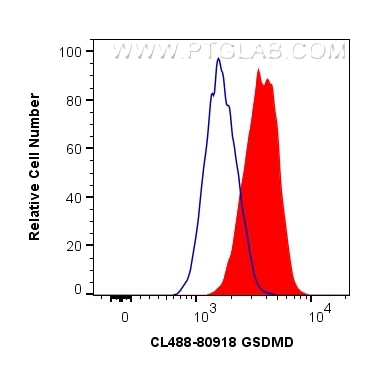CoraLite® Plus 488-conjugated GSDMD Recombinant antibody
GSDMD Recombinant Antibody for FC (Intra)
Host / Isotype
Rabbit / IgG
Reactivity
Human, mouse
Applications
FC (Intra)
Conjugate
CoraLite® Plus 488 Fluorescent Dye
CloneNo.
2N24
Cat no : CL488-80918
Synonyms
Validation Data Gallery
Tested Applications
| Positive FC detected in | RAW 264.7 cells |
Recommended dilution
| Application | Dilution |
|---|---|
| Flow Cytometry (FC) | FC : 0.80 ug per 10^6 cells in a 100 µl suspension |
| It is recommended that this reagent should be titrated in each testing system to obtain optimal results. | |
| Sample-dependent, Check data in validation data gallery. | |
Product Information
CL488-80918 targets GSDMD in FC (Intra) applications and shows reactivity with Human, mouse samples.
| Tested Reactivity | Human, mouse |
| Host / Isotype | Rabbit / IgG |
| Class | Recombinant |
| Type | Antibody |
| Immunogen | GSDMD fusion protein Ag14757 |
| Full Name | gasdermin D |
| Calculated Molecular Weight | 484 aa, 53 kDa |
| Observed Molecular Weight | 50-53 kDa |
| GenBank Accession Number | BC008904 |
| Gene Symbol | GSDMD |
| Gene ID (NCBI) | 79792 |
| Conjugate | CoraLite® Plus 488 Fluorescent Dye |
| Excitation/Emission Maxima Wavelengths | 493 nm / 522 nm |
| Form | Liquid |
| Purification Method | Protein A purification |
| Storage Buffer | PBS with 50% Glycerol, 0.05% Proclin300, 0.5% BSA, pH 7.3. |
| Storage Conditions | Store at -20°C. Avoid exposure to light. Stable for one year after shipment. Aliquoting is unnecessary for -20oC storage. 20ul sizes contain 0.1% BSA. |
Background Information
GSDMD is a member of the gasdermin family. Members of this family appear to play a role in regulation of epithelial proliferation. GSDMD has been suggested to act as a tumor suppressor. Recently, GSDMD is identified as a new component of inflammasomes, and it is an executor of pyroptosis and required for interleukin-1β secretion. Cleavage of GSDMD by inflammatory caspases determines pyroptotic cell death.
Protocols
| Product Specific Protocols | |
|---|---|
| FC protocol for CL Plus 488 GSDMD antibody CL488-80918 | Download protocol |
| Standard Protocols | |
|---|---|
| Click here to view our Standard Protocols |


